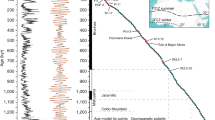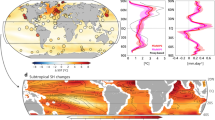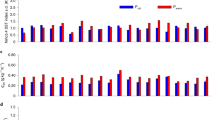Abstract
The Younger Dryas cooling event disrupted the overall warming trend in the North Atlantic region during the last deglaciation1,2,3,4,5,6. Climate change during the Younger Dryas was abrupt7,8,9, and thus provides insights into the sensitivity of the climate system to perturbations. The sudden Younger Dryas cooling has traditionally been attributed to a shutdown of the Atlantic Meridional Overturning Circulation by meltwater discharges10,11,12,13. However, alternative explanations such as strong negative radiative forcing14 and a shift in atmospheric circulation15 have also been offered. Here we investigate the importance of these different forcings in coupled climate model experiments constrained by data assimilation. We find that the Younger Dryas climate signal as registered in proxy evidence is best simulated using a combination of processes: a weakened Atlantic Meridional Overturning Circulation, moderate negative radiative forcing and an altered atmospheric circulation. We conclude that none of the individual mechanisms alone provide a plausible explanation for the Younger Dryas cold period. We suggest that the triggers for abrupt climate changes such as the Younger Dryas are more complex than suggested so far, and that studies on the response of the climate system to perturbations should account for this complexity.
This is a preview of subscription content, access via your institution
Access options
Subscribe to this journal
Receive 12 print issues and online access
$259.00 per year
only $21.58 per issue
Buy this article
- Purchase on Springer Link
- Instant access to full article PDF
Prices may be subject to local taxes which are calculated during checkout



Similar content being viewed by others
References
Alley, R. B. et al. Abrupt climate change. Science 299, 2005–2010 (2003).
Ganopolski, A. & Roche, D. M. On the nature of lead–lag relationships during glacial–interglacial climate transitions. Quat. Sci. Rev. 28, 3361–3378 (2009).
Denton, G. H. et al. The Last Glacial Termination. Science 328, 1652–1656 (2010).
Shakun, J. D. & Carlson, A. E. A global perspective on Last Glacial Maximum to Holocene climate change. Quat. Sci. Rev. 29, 1801–1816 (2010).
Clark, P. U. et al. Global climate evolution during the last deglaciation. Proc. Natl Acad. Sci. USA 109, E1134–E1142 (2012).
Shakun, J. D. et al. Global warming preceded by increasing carbon dioxide concentrations during the last deglaciation. Nature 484, 49–54 (2012).
Steffensen, J. P. et al. High-resolution Greenland ice core data show abrupt climate change happens in few years. Science 321, 680–684 (2008).
Brauer, A., Haug, G. H., Dulski, P., Sigman, D. M. & Negendank, J. F. W. An abrupt wind shift in western Europe at the onset of the Younger Dryas cold period. Nature Geosci. 1, 520–523 (2008).
Bakke, J. et al. Rapid oceanic and atmospheric changes during the Younger Dryas cold period. Nature Geosci. 2, 202–205 (2009).
Broecker, W. S., Peteet, D. M. & Rind, D. Does the ocean–atmosphere system have more than one stable mode of operation? Nature 315, 21–26 (1985).
Stocker, T. F. & Wright, D. G. Rapid transitions of the ocean’s deep circulation induced by changes in the surface water fluxes. Nature 351, 729–732 (1991).
Rahmstorf, S. Bifurcations of the Atlantic thermohaline circulation in response to changes in the hydrological cycle. Nature 378, 145–149 (1995).
Meissner, K. J. Younger Dryas: A data to model comparison to constrain the strength of the overturning circulation. Geophys. Res. Lett. 34, L21705 (2007).
Firestone, R. B. et al. Evidence for an extraterrestrial impact 12,900 years ago that contributed to the megafaunal extinctions and the Younger Dryas cooling. Proc. Natl Acad. Sci. USA 104, 16016–16021 (2007).
Wunsch, C. Abrupt climate change: An alternative view. Quat. Res. 65, 191–203 (2006).
Heiri, O. et al. Validation of climate model-inferred regional temperature change for late glacial Europe. Nature Commun. 5, 4914 (2014).
Berger, A. & Loutre, M. F. Insolation values for the climate of the last 10 million years. Quat. Sci. Rev. 10, 297–317 (1991).
Stenni, B. et al. Expression of the bipolar see-saw in Antarctic climate records during the last deglaciation. Nature Geosci. 4, 46–49 (2011).
Manabe, S. & Stouffer, R. J. Coupled atmosphere-ocean model response to freshwater input: Comparison to the Younger Dryas event. Paleoceanography 12, 321–336 (1997).
McManus, J. F., Francois, R., Gherardi, J. M., Keigwin, L. D. & Brown-Leger, S. Collapse and rapid resumption of Atlantic Meridional Circulation linked to deglacial climate changes. Nature 428, 834–837 (2004).
Barker, S. et al. Extreme deepening of the Atlantic Overturning Circulation during deglaciation. Nature Geosci. 3, 567–571 (2010).
Renssen, H., van Geel, B., van der Plicht, J. & Magny, M. Reduced solar activity as a trigger for the start of the Younger Dryas? Quat. Int. 68–71, 373–383 (2000).
Hillaire-Marcel, C., de Vernal, A., Bilodeau, G. & Weaver, A. J. Absence of deep-water formation in the Labrador Sea during the last interglacial period. Nature 410, 1073–1077 (2001).
Murton, J. B., Bateman, M. D., Dallimore, S. R., Teller, J. T. & Yang, Z. Identification of Younger Dryas outburst flood path from Lake Agassiz to the Arctic Ocean. Nature 464, 740–743 (2010).
Tarasov, L. & Peltier, W. R. Arctic freshwater forcing of the Younger Dryas cold reversal. Nature 435, 662–665 (2005).
Condron, A. & Winsor, P. Meltwater routing and the Younger Dryas. Proc. Natl Acad. Sci. USA 109, 19928–19933 (2012).
Goosse, H. et al. Description of the Earth system model of intermediate complexity LOVECLIM version 1.2. Geosci. Model Dev. 3, 603–633 (2010).
Dubinkina, S., Goosse, H., Damas-Sallaz, Y., Crespin, E. & Crucifix, M. Testing a particle filter to reconstruct climate changes over the past centuries. Int. J. Bifurcat. Chaos 21, 3611–3618 (2011).
Mathiot, P. et al. Using data assimilation to investigate the causes of Southern Hemisphere high latitude cooling from 10 to 8 ka BP. Clim. Past 9, 887–901 (2013).
Mairesse, A., Goosse, H., Mathiot, P., Wanner, H. & Dubinkina, S. Investigating the consistency between proxy-based reconstructions and climate models using data assimilation: A mid-Holocene case study. Clim. Past 9, 2741–2757 (2013).
Acknowledgements
The research leading to these results has received funding from the European Union’s Seventh Framework programme (FP7/2007-2013) under grant agreement no. 243908, ‘Past4Future. Climate change—Learning from the past climate’. H.R. was supported by a visiting professor grant of the Université catholique de Louvain. H.G. is Senior Research Associate with the Fonds de la Recherche Scientifique (FRS—FNRS-Belgium). D.M.R. is supported by the Netherlands Organization for Scientific Research (NWO) and by the French CNRS.
Author information
Authors and Affiliations
Contributions
All authors contributed substantially to this work. H.R. and H.G. conceived the project. H.R., A.M., H.G. and P.M. designed and performed the LOVECLIM experiments. H.R., A.M. and H.G. analysed the model results. O.H. provided proxy-based reconstructions. D.M.R. provided unpublished initial conditions and forcings for the experiments. P.J.V. and K.H.N. performed additional experiments with other models. The manuscript was written by H.R., with input from all other authors.
Corresponding author
Ethics declarations
Competing interests
The authors declare no competing financial interests.
Supplementary information
Supplementary Information
Supplementary Information (PDF 2652 kb)
Rights and permissions
About this article
Cite this article
Renssen, H., Mairesse, A., Goosse, H. et al. Multiple causes of the Younger Dryas cold period. Nature Geosci 8, 946–949 (2015). https://doi.org/10.1038/ngeo2557
Received:
Accepted:
Published:
Issue Date:
DOI: https://doi.org/10.1038/ngeo2557
This article is cited by
-
Evolution characteristics of the Atlantic Meridional Overturning Circulation and its thermodynamic and dynamic effects on surface air temperature in the Northern Hemisphere
Science China Earth Sciences (2023)
-
Frequency of the winter temperature extremes over Siberia dominated by the Atlantic Meridional Overturning Circulation
npj Climate and Atmospheric Science (2022)
-
Synchronous vegetation response to the last glacial-interglacial transition in northwest Europe
Communications Earth & Environment (2022)
-
Precise date for the Laacher See eruption synchronizes the Younger Dryas
Nature (2021)
-
Seasonal evolution differences of east Asian summer monsoon precipitation between Bølling-Allerød and younger Dryas periods
Climatic Change (2021)



